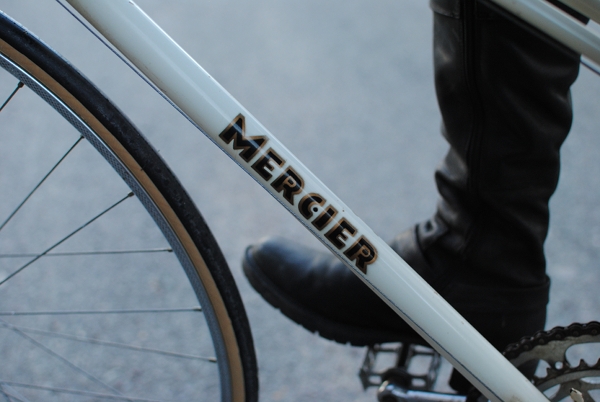 Posting this at the end of April Fool's Day might raise suspicion, but I promise it's true: I have another "new" bike. The Co-Habitant and I were returning home from some errands and minding our own business, not even remotely entertaining the possibility of new bike acquisitions...
Posting this at the end of April Fool's Day might raise suspicion, but I promise it's true: I have another "new" bike. The Co-Habitant and I were returning home from some errands and minding our own business, not even remotely entertaining the possibility of new bike acquisitions... ...when we saw a striking, if slightly decrepit, cream and black Mercier mixte outside of a nearby bike store. This was not the typical mixte we tend to see in these parts, so we got curious. After trying the bicycle I was amazed at how wonderfully it rode - despite the slick 20mm tires the bike shop chose to fit it with! The poor, lonely Mercier was for sale at a very modest sum.
...when we saw a striking, if slightly decrepit, cream and black Mercier mixte outside of a nearby bike store. This was not the typical mixte we tend to see in these parts, so we got curious. After trying the bicycle I was amazed at how wonderfully it rode - despite the slick 20mm tires the bike shop chose to fit it with! The poor, lonely Mercier was for sale at a very modest sum. Half an hour later, I was pedaling it home (after paying for it of course), and now the Mercier is mine!
Half an hour later, I was pedaling it home (after paying for it of course), and now the Mercier is mine! Mercier was a well-respected French bicycle manufacturer in the 1960s and 70s, competing with Peugeot, Motobecane and Gitane. Mysteriously, almost no information is now available on the original Mercier (even the wikipedia entry has been deleted). Though a new company now exists under the same brand name, it has no relation to the original manufacturer.
Mercier was a well-respected French bicycle manufacturer in the 1960s and 70s, competing with Peugeot, Motobecane and Gitane. Mysteriously, almost no information is now available on the original Mercier (even the wikipedia entry has been deleted). Though a new company now exists under the same brand name, it has no relation to the original manufacturer. I don't know where to start describing why I like this bicycle and feel that I must have it. For one thing, there is the attractive lugging. Here is the seat cluster with pinstriping detail on the top of the stays.
I don't know where to start describing why I like this bicycle and feel that I must have it. For one thing, there is the attractive lugging. Here is the seat cluster with pinstriping detail on the top of the stays.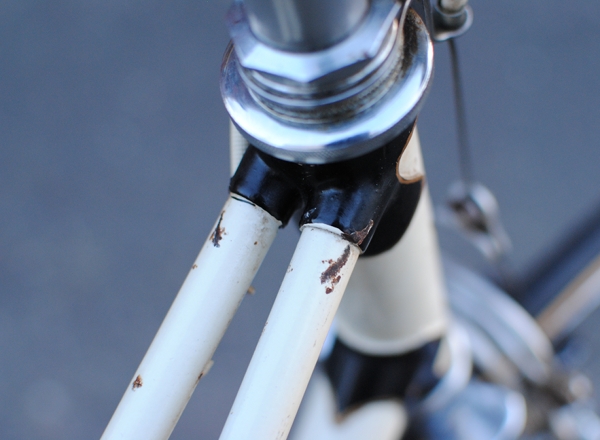 Split headtube lug for the twin lateral stays - something my Motobecane mixte does not have.
Split headtube lug for the twin lateral stays - something my Motobecane mixte does not have.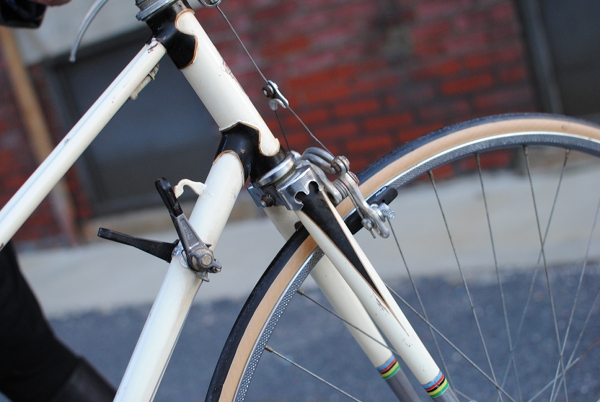 Headtube lugs, fork crown, and pinstriping on the fork. Downtube shifters (which I do not find particularly attractive, but can easily replace). Overall, the lugwork and other aspects of the bicycle's "decor" are charmingly eccentric compared to other mixtes I have seen.
Headtube lugs, fork crown, and pinstriping on the fork. Downtube shifters (which I do not find particularly attractive, but can easily replace). Overall, the lugwork and other aspects of the bicycle's "decor" are charmingly eccentric compared to other mixtes I have seen.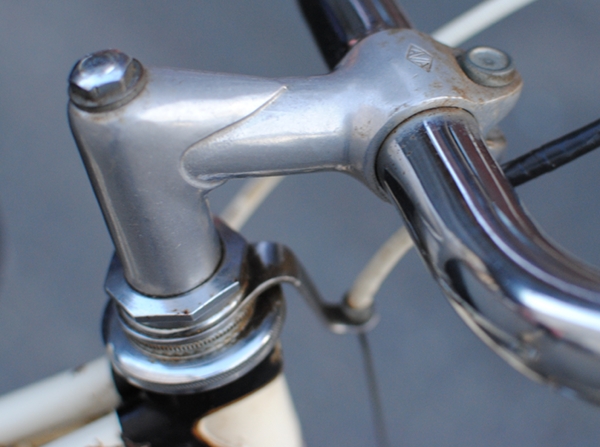 The components seem to be a mixed bag of lower and higher end. The stem, which I find beautiful, is an AVA stem, which Sheldon Brown described as follows:
The components seem to be a mixed bag of lower and higher end. The stem, which I find beautiful, is an AVA stem, which Sheldon Brown described as follows:"Many higher-quality French bicycles of the '70's came with AVA brand bars and stems. These have a reputation for failure, and should be replaced if the bike is to be ridden hard or fast."Hmmm... "higher quality" and "failure" in the same sentence? Should I interpret this to mean that as long as I don't race on the bike, the AVA stem will be okay? That is how I would like to interpret it. Advice welcome.
 The handlebars are a narrow version of North Roads (what I imagine Nitto's "Dove Bars" are like) and seem original. I prefer narrower bars and love how these feel when I ride the Mercier: they give me a great deal of control and my hands don't seem to grow tired.
The handlebars are a narrow version of North Roads (what I imagine Nitto's "Dove Bars" are like) and seem original. I prefer narrower bars and love how these feel when I ride the Mercier: they give me a great deal of control and my hands don't seem to grow tired.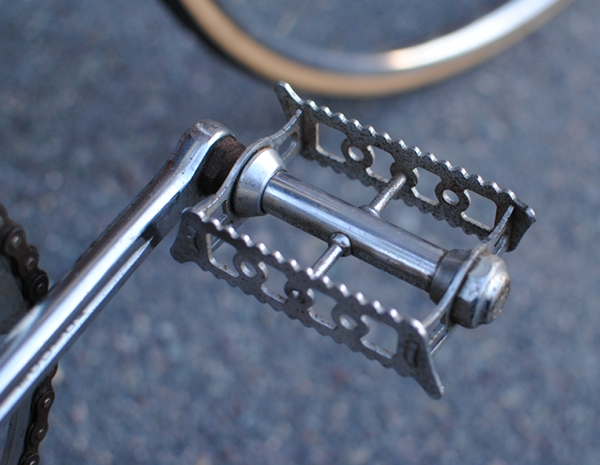 The beautiful Lyotard pedals feel great.
The beautiful Lyotard pedals feel great.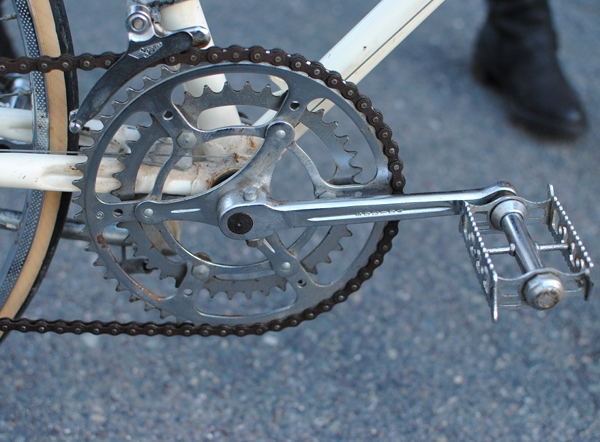 Simplex front and rear derailleur, as well as Simplex dropouts. Classic 10-speed gearing.
Simplex front and rear derailleur, as well as Simplex dropouts. Classic 10-speed gearing. From what I understand, this rear Simplex derailleur is not good. I am pretty sure it's plastic. The spoke protector ("pie plate") is also original and stamped "made in France".
From what I understand, this rear Simplex derailleur is not good. I am pretty sure it's plastic. The spoke protector ("pie plate") is also original and stamped "made in France".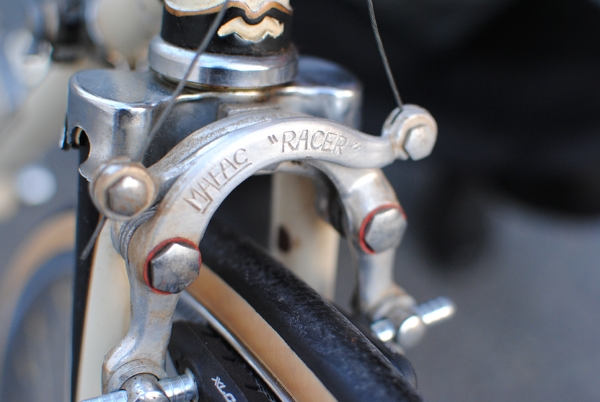 Mafac "Racer" centerpull brakes, which I believe are pretty good. However, the bike has steel rims (bad for braking), so I need to think of a solution to this.
Mafac "Racer" centerpull brakes, which I believe are pretty good. However, the bike has steel rims (bad for braking), so I need to think of a solution to this.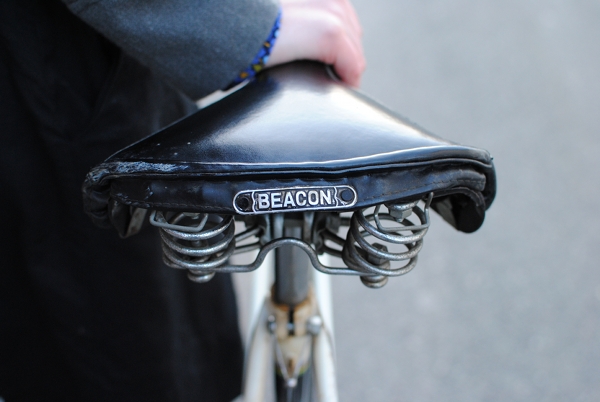 "Beacon" pleather sprung saddle. Feels comfortable so far, but I imagine that after a long ride it will not. I will probably replace it with one of my vintage B72s - but first I want to ride on this one down Beacon Street.
"Beacon" pleather sprung saddle. Feels comfortable so far, but I imagine that after a long ride it will not. I will probably replace it with one of my vintage B72s - but first I want to ride on this one down Beacon Street. This Mercier is a 20" frame, whereas my Motobecane is a 21" frame. This is visible in the heights of their seat tubes, but oddly enough their head tubes and stems are about even - despite the fact that the Motobecane has a modern, extended Nitto stem. The Co-Habitant thinks that this is because the Mercier's virtual top tube is upward-sloping, allowing for the handlebars to be higher in their standard position. Whatever the reason, the Mercier does not feel like it is too small; it feels just perfect and is extremely comfortable to ride.
This Mercier is a 20" frame, whereas my Motobecane is a 21" frame. This is visible in the heights of their seat tubes, but oddly enough their head tubes and stems are about even - despite the fact that the Motobecane has a modern, extended Nitto stem. The Co-Habitant thinks that this is because the Mercier's virtual top tube is upward-sloping, allowing for the handlebars to be higher in their standard position. Whatever the reason, the Mercier does not feel like it is too small; it feels just perfect and is extremely comfortable to ride.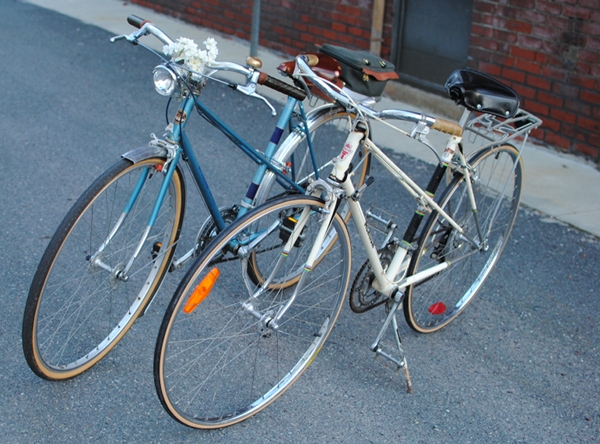 Here is another side by side comparison. Though they are both French mixtes from the 1970s, I find the Mercier to be a considerably more comfortable ride than the Motobecane. What elusive aspect of the bikes' geometries and/or components account for this I do not know, but it is so. The Mercier was a pleasure to ride from the first moment, whereas the Motobecane required "taming" and is still a bit too "racy" for me even with the many changes I've made in attempts to make it more comfortable for everyday cycling.
Here is another side by side comparison. Though they are both French mixtes from the 1970s, I find the Mercier to be a considerably more comfortable ride than the Motobecane. What elusive aspect of the bikes' geometries and/or components account for this I do not know, but it is so. The Mercier was a pleasure to ride from the first moment, whereas the Motobecane required "taming" and is still a bit too "racy" for me even with the many changes I've made in attempts to make it more comfortable for everyday cycling.So, I am considering doing one of the following:
A. Cannibalizing the better components from the Motobecane (derailleur, shifters, and - is this possible? - wheels) and building up the Mercier as my perfect vintage mixte. Then sell off the Motobecane for cheap.
B. Converting the Mercier to a single speed, or possibly even fixed gear (you know, to practice for the velodrome). This should be relatively easy and unintrusive, given that it has clamp-on derailleur and shifters, and compatible drop-outs.
Any opinions and advice regarding these options would be much appreciated!

 I didn't quite make it down to the beach for the sunrise, but the sun was playing hide and seek through the clouds when I got there.
I didn't quite make it down to the beach for the sunrise, but the sun was playing hide and seek through the clouds when I got there. It was a chilly morning, but that is sand, not snow.
It was a chilly morning, but that is sand, not snow. Surf and Sea Foam.
Surf and Sea Foam. Sand and Sea Shells.
Sand and Sea Shells. Wind-blown patterns in the sand.
Wind-blown patterns in the sand.














 The western side of Mount Saint Helens as seen from the Visitor Center at Silver Lake, 46 road-miles away.
The western side of Mount Saint Helens as seen from the Visitor Center at Silver Lake, 46 road-miles away. From a viewpoint on the north-northwest side.
From a viewpoint on the north-northwest side. Clouds covered the upper half of the volcano for the entire afternoon with an occasional break, which briefly revealed the peaks. This, and the remaining photos were taken from the Johnston Ridge Observatory. Named for David A. Johnston, a volcanologist on duty nearby on that fateful day. His last words were “Vancouver, this is it!”
Clouds covered the upper half of the volcano for the entire afternoon with an occasional break, which briefly revealed the peaks. This, and the remaining photos were taken from the Johnston Ridge Observatory. Named for David A. Johnston, a volcanologist on duty nearby on that fateful day. His last words were “Vancouver, this is it!” The lateral blast exploded to the north toward what is now Johnston Ridge and, quite literally, destroyed everything in its path.
The lateral blast exploded to the north toward what is now Johnston Ridge and, quite literally, destroyed everything in its path. The mountains and valleys were tall old-growth forest. Now all that remains are a few denuded logs lying about like pick-up-sticks.
The mountains and valleys were tall old-growth forest. Now all that remains are a few denuded logs lying about like pick-up-sticks.
 A park service sign nearby tells a tale of the blast as “spoken” by this stump: “Step up and look at me carefully. Notice my shattered trunk, my missing top. I once stood 150 feet tall, surrounded by a beautiful forest of green and growing trees. When the blast exploded sideways out of the mountain, it plowed through the debris avalanche and swept across the landscape, picking up and carrying large chunks of rock, ice, and splintered wood.”
A park service sign nearby tells a tale of the blast as “spoken” by this stump: “Step up and look at me carefully. Notice my shattered trunk, my missing top. I once stood 150 feet tall, surrounded by a beautiful forest of green and growing trees. When the blast exploded sideways out of the mountain, it plowed through the debris avalanche and swept across the landscape, picking up and carrying large chunks of rock, ice, and splintered wood.” Down in the valley, the blast dumped 680 feet of debris, filling Spirit Lake to the east with logs and ash.
Down in the valley, the blast dumped 680 feet of debris, filling Spirit Lake to the east with logs and ash. Johnston Ridge was completely denuded. Spirit Lake lies beneath the far ridge at left-center and St. Helens rises up from the valley on the right.
Johnston Ridge was completely denuded. Spirit Lake lies beneath the far ridge at left-center and St. Helens rises up from the valley on the right. The early evening light emphasizes the ridges and the gulleys now being carved out by the flow of water.
The early evening light emphasizes the ridges and the gulleys now being carved out by the flow of water. Another view of cloud shrouded St. Helens from Johnston Ridge in the early evening. All photos were taken on Sunday, September 12th.
Another view of cloud shrouded St. Helens from Johnston Ridge in the early evening. All photos were taken on Sunday, September 12th.






